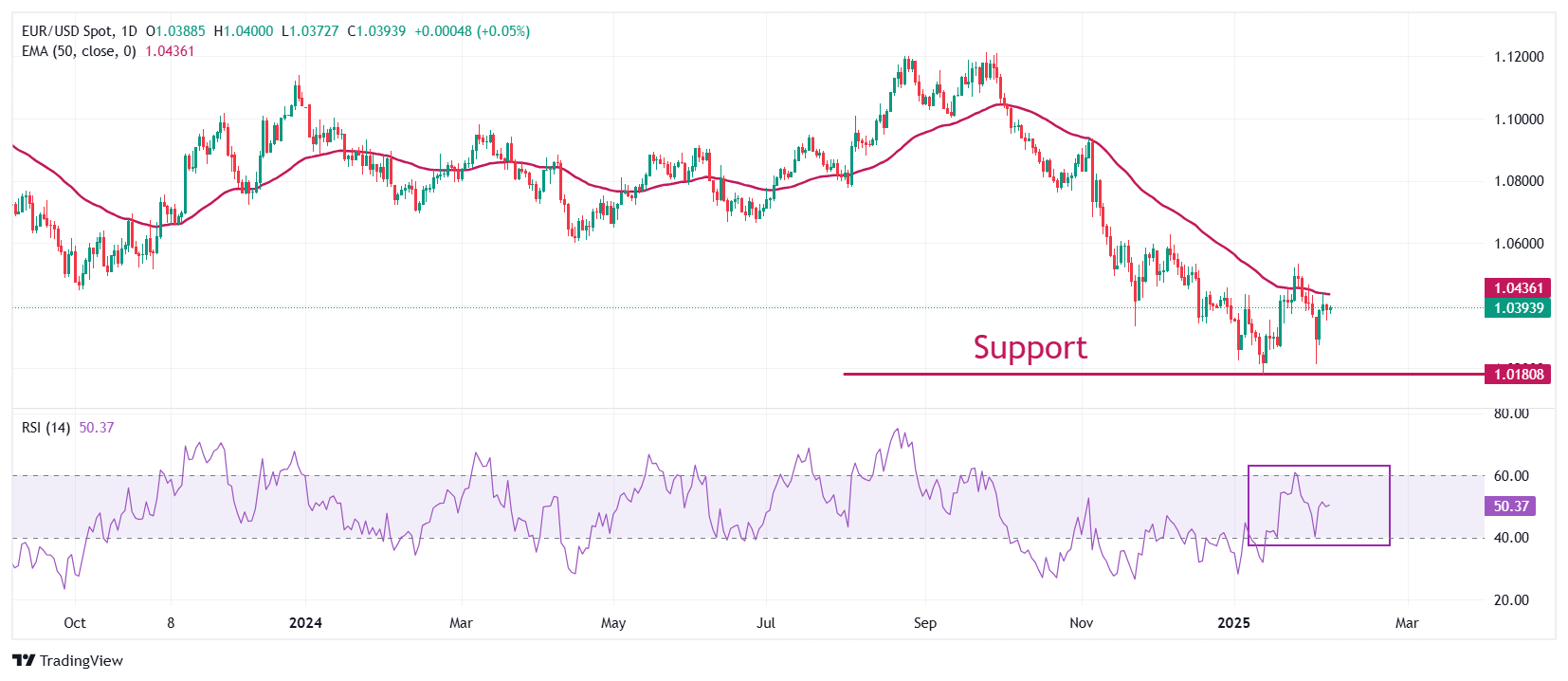- EUR/USD drops to near 1.0360 after the release of the US NFP data for January.
- The Fed is expected to cut interest rates in the June policy meeting.
- ECB’s Cipollone expects the impact of tariffs on China to be deflationary for the Eurozone.
EUR/USD slides to near 1.0360 in Friday’s North American session as the US Dollar (USD) gains after the release of the United States (US) Nonfarm Payrolls (NFP) data for January. The US Dollar Index (DXY), which tracks the Greenback’s value against six major currencies, gains to near 107.90. The US NFP report showed that the labor demand remained modest, while Average Hourly Earnings heated.
In January, the economy added 143K workers, fewer than estimates of 170K and 307K in December, upwardly revised from 256K. The Unemployment Rate decelerated to 4%, while it was expected to remain steady at 4.1%. Average Hourly Earnings data, a key measure of wage growth that drives consumer spending unexpectedly accelerated to 4.1% year-on-year from 3.9% in December. Economists expected the wage growth measure to have grown at a slower pace of 3.8%. On month, Average Hourly Earnings rose at a faster pace of 0.5%, compared to expectations and the former release of 0.3%.
It would be difficult for market participants to ascertain the impact of the US NFP report on market expectations for the Federal Reserve's monetary policy outlook.
Last week, Fed Chair Jerome Powell said the central bank would make monetary policy adjustments only after seeing “real progress in inflation or at least some weakness in labor market” after the Fed left interest rates unchanged in the range of 4.25%-4.50%.
Daily digest market movers: EUR/USD drops as ECB dovish bets remain firm
- EUR/USD faces selling pressure near 1.0400 as the outlook for the Euro (EUR) remains uncertain amid concerns that the Eurozone is likely to feel the pain of higher tariffs by US President Donald Trump. Last weekend, President Trump warned that Europe will definitely face tariffs for not buying enough American goods, but didn’t provide much information.
- Analysts at Macquarie said President Trump held back specific tariff threats on the Eurozone because of "the lack of a stable government in Germany and France.” Still, they warned that a US tariff bomb would likely find “fertile ground in the EU” and escalate unresolved issues rapidly into trade tensions, given that “Europe is target-rich”.
- In addition to global issues, the Eurozone outlook is also vulnerable because of domestic concerns. Growing risks of economic uncertainty have forced European Central Bank (ECB) officials to guide a dovish monetary policy outlook. ECB’s executive board member Piero Cipollone said in an interview with Reuters on Thursday that all officials agree “there is still room for adjusting rates downwards”.
- When asked about the impact of President Trump’s tariffs on the Eurozone, Cipollone said, “If tariffs are imposed on us, the most immediate impact will be on growth”. He also added that tariffs on China would compel it to look to the shared bloc for dumping its goods due to tariffs from the US. Such a scenario will be deflationary for the economy.
Technical Analysis: EUR/USD remains below 50-day EMA
EUR/USD falls slightly to near 1.0370 in North American trading hours on Friday ahead of the US NFP employment data. The major currency pair faces pressure near the 50-day Exponential Moving Average (EMA) around 1.0436, suggesting that the overall trend is still bearish.
The 14-day Relative Strength Index (RSI) oscillates in the 40.00-60.00 range, indicating a sideways trend.
Looking down, the January 13 low of 1.0177 and the round-level support of 1.0100 will act as major support zones for the pair. Conversely, the psychological resistance of 1.0500 will be the key barrier for the Euro bulls.
Economic Indicator
Average Hourly Earnings (YoY)
The Average Hourly Earnings gauge, released by the US Bureau of Labor Statistics, is a significant indicator of labor cost inflation and of the tightness of labor markets. The Federal Reserve Board pays close attention to it when setting interest rates. A high reading is seen as bullish for the US Dollar (USD), while a low reading is seen as bearish.
Read more.Last release: Fri Feb 07, 2025 13:30
Frequency: Monthly
Actual: 4.1%
Consensus: 3.8%
Previous: 3.9%
Source: US Bureau of Labor Statistics
Information on these pages contains forward-looking statements that involve risks and uncertainties. Markets and instruments profiled on this page are for informational purposes only and should not in any way come across as a recommendation to buy or sell in these assets. You should do your own thorough research before making any investment decisions. FXStreet does not in any way guarantee that this information is free from mistakes, errors, or material misstatements. It also does not guarantee that this information is of a timely nature. Investing in Open Markets involves a great deal of risk, including the loss of all or a portion of your investment, as well as emotional distress. All risks, losses and costs associated with investing, including total loss of principal, are your responsibility. The views and opinions expressed in this article are those of the authors and do not necessarily reflect the official policy or position of FXStreet nor its advertisers. The author will not be held responsible for information that is found at the end of links posted on this page.
If not otherwise explicitly mentioned in the body of the article, at the time of writing, the author has no position in any stock mentioned in this article and no business relationship with any company mentioned. The author has not received compensation for writing this article, other than from FXStreet.
FXStreet and the author do not provide personalized recommendations. The author makes no representations as to the accuracy, completeness, or suitability of this information. FXStreet and the author will not be liable for any errors, omissions or any losses, injuries or damages arising from this information and its display or use. Errors and omissions excepted.
The author and FXStreet are not registered investment advisors and nothing in this article is intended to be investment advice.
Recommended content
Editors’ Picks

EUR/USD stabilizes above 1.1350 on Easter Friday
EUR/USD enters a consolidation phase above 1.1350 on Friday as the trading action remains subdued, with major markets remaining closed in observance of the Easter Holiday. On Thursday, the European Central Bank (ECB) announced it cut key rates by 25 bps, as expected.

GBP/USD fluctuates below 1.3300, looks to post weekly gains
After setting a new multi-month high near 1.3300 earlier in the week, GBP/USD trades in a narrow band at around 1.32700 on Friday and remains on track to end the week in positive territory. Markets turn quiet on Friday as trading conditions thin out on Easter Holiday.

Gold ends week with impressive gains above $3,300
Gold retreated slightly from the all-time high it touched at $3,357 early Thursday but still gained more than 2% for the week after settling at $3,327. The uncertainty surrounding US-China trade relations caused markets to adopt a cautious stance, boosting safe-haven demand for Gold.

How SEC-Ripple case and ETF prospects could shape XRP’s future
Ripple consolidated above the pivotal $2.00 level while trading at $2.05 at the time of writing on Friday, reflecting neutral sentiment across the crypto market.

Future-proofing portfolios: A playbook for tariff and recession risks
It does seem like we will be talking tariffs for a while. And if tariffs stay — in some shape or form — even after negotiations, we’ll likely be talking about recession too. Higher input costs, persistent inflation, and tighter monetary policy are already weighing on global growth.

The Best brokers to trade EUR/USD
SPONSORED Discover the top brokers for trading EUR/USD in 2025. Our list features brokers with competitive spreads, fast execution, and powerful platforms. Whether you're a beginner or an expert, find the right partner to navigate the dynamic Forex market.




